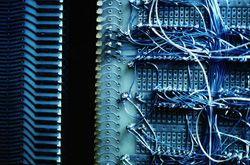'Spintronics' for future quantum micro-devices
Spin refers to the intrinsic angular momentum that characterises each kind of elementary particle. Particularly in quantum mechanics spin is an important parameter for atomic scale systems such as atoms, protons and electrons and it is closely related to magnetism. In informatics spin can be used as a binary information carrier in spin semiconductors. The so-called 'spin electronics' or 'spintronics' is a new field that has drawn considerable attention during the past fifteen years. In spintronics information relies on electron spin carriers rather than electron charge and it is stored into spins as a particular spin orientation, either up or down. The relatively long duration of spin orientation of conduction electrons renders spintronics devices very suitable for memory storage and magnetic sensor applications. By combining microelectronics with spin-dependent effects coming from the interaction between spin of the carrier and the magnetic properties of the material, new routes for the generation of new advanced devices have opened. One of the most critical issues is the ability to inject, manipulate and detect spins in solid state systems. Several approaches have been investigated including magnetic metal/semiconductor junctions, metallic devices and semiconductors. The SPINOSA project focused on developing contacts for spin injection into semiconductors with the objective to provide innovative spintronics applications at room temperature. Part of project work involved development of tunnelling contacts and barriers for hot electron injection using ferromagnetic materials. Researchers investigated strong tunnelling magneto-resistance phenomena occurring in stack of a ferromagnetic semiconductor. This resistance heavily relies on the change in the density of states in the ferromagnetic material with the changing direction of the magnetisation with respect to the lattice. Furthermore, in a layers stack with two ferromagnetic layers this effect can be strongly enhanced. These results offer a better insight in spin injection processes and are expected to be exploited in the improvement of magnetoelectronic devices. For more information click at: http://www.physik.uni-wuerzburg.de/EP3/Arbeitsgruppen/Spinosa/SPINOSA.html(opens in new window)







